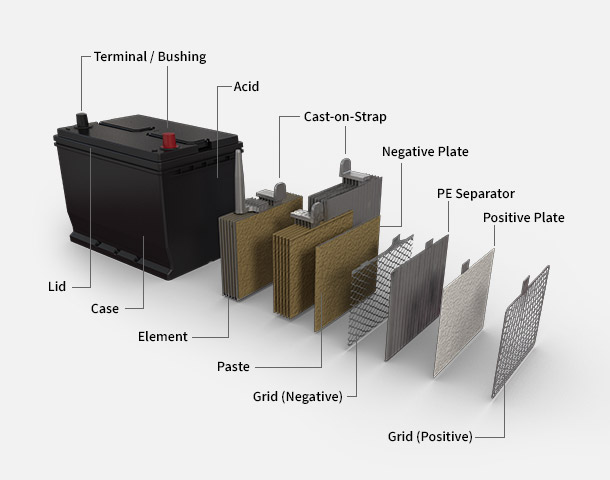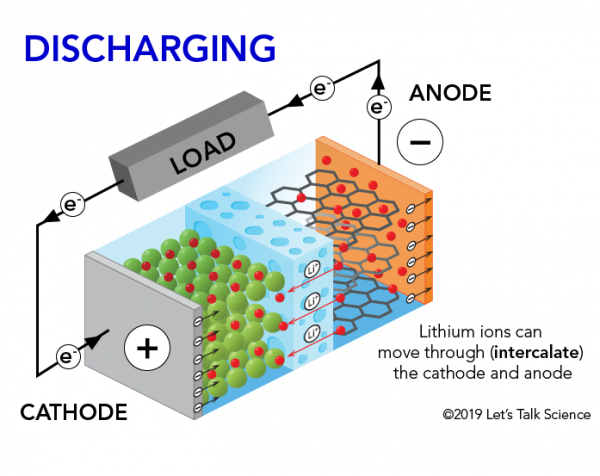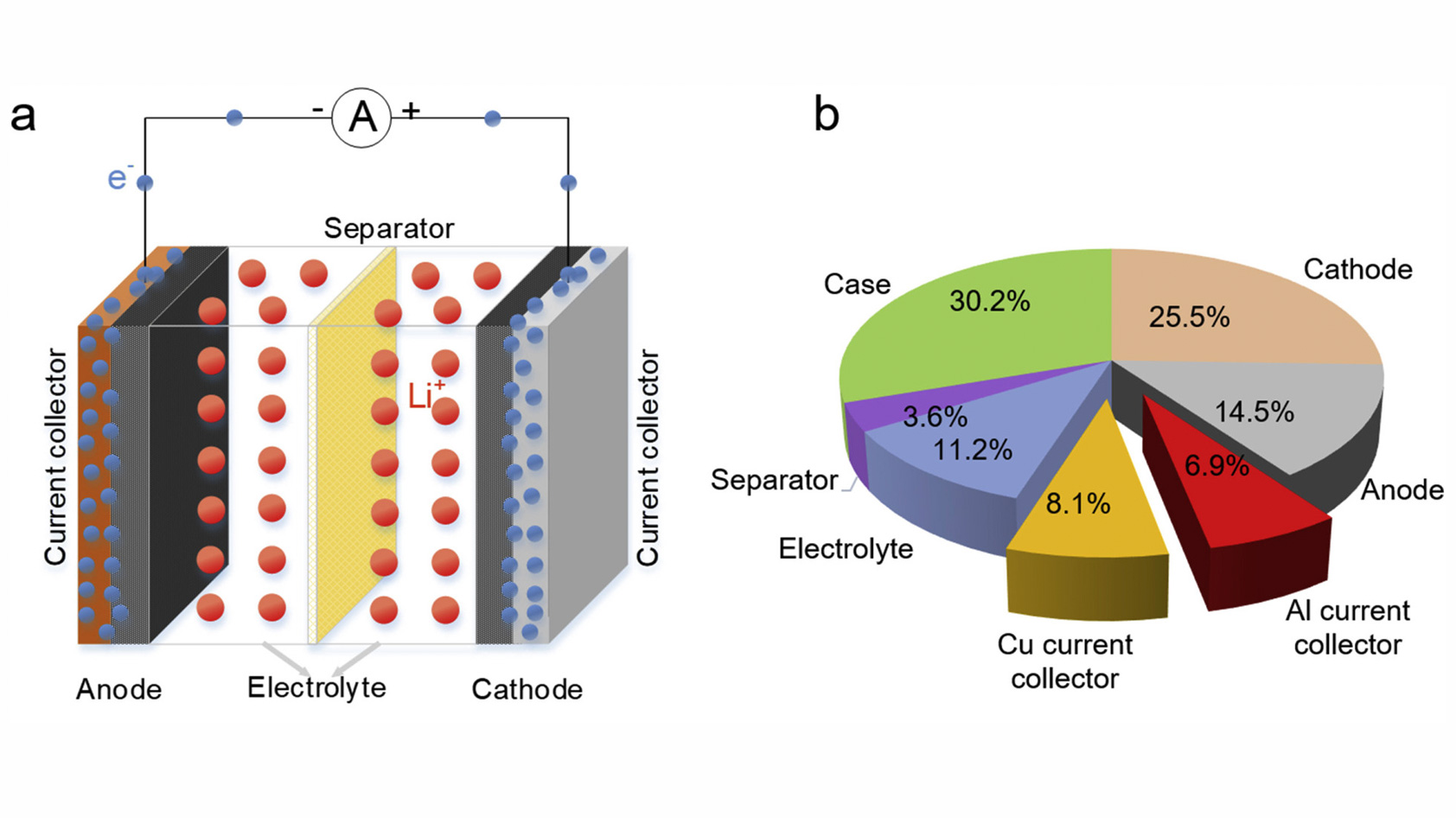The chemicals that are typically used in batteries are heavy metallic elements which are toxic even in minute quantities. The composition of an EV battery might vary slightly depending on the types of electric vehicles but generally EV batteries are composed of cells modules and a pack.

How A Car Battery Works The Engineering Mindset
The answer to what is inside a battery starts with a breakdown of what makes a battery a battery.

. An automobile battery is an example of a wet cell battery with six cells. Each cell is filled with a sulfuric acid solution which is the electrolyte. So how long does a car battery last.
The conventional lead acid battery lasts 3-5 years on average. Because of its name lithium-ion li-ion people think that li-ion batteries are primarily made of lithium and that if we transition the worlds car fleet to. A modern disposable battery commonly contains zinc manganese dioxide and an alkaline solution while a modern rechargeable battery is primarily made up of lithium-carbon cobalt dioxide and an organic solution with dissolved lithium salts.
Lithium cobalt nickel and graphite are integral materials in the composition of lithium-ion batteries LIBs for electric vehicles. Copper itself is not reactive even if dilute sulphuric acid is poured on it. The balance is electrolyte separators and the case.
The density of the sulfuric acid is 125 kilograms per liter and the pH level is about 08. Graphite is used for the anode the negative pole. Cathode A combo of manganese dioxide and carbon cathodes are the electrodes reduced by the electrochemical reaction.
This is a new type of batteries which arrived in the 1990s and replaced metallic lithium with lithium ions. However the car battery chemical is a volatile and dangerous chemical and proper protection should always be used replacing the chemical. Container Steel can that houses the cells ingredients to form the cathode a part of the electrochemical reaction.
The average car battery life also depends on its chemical composition as there are different car battery types. Pb s H2SO4 aq PbSO4 aq H2 g Sometimes it also happens that copper clamps or ringed copper terminals which are used to connect battery with wires corrode. Heres the average battery life of some common car batteries.
The zinc-carbon chemistry is common in many inexpensive AAA AA C and D dry cell batteries. The electrolyte is a lithium salt in a dissolved solution known as a solvent which is usually ethylene carbonate. The chemical composition of electric car batteries also keeps changing as we move ahead in time.
Different car makers use different cathode chemistries for lithium ion batteries Tesla uses NCA chemistry or Nickel Cobalt and Aluminium LiNiCoAlO2. The car battery contains at least 30 to 50 percent of sulfuric acid in water with 29 of sulfuric acid. Lithium cobalt oxide LCO LCO batteries are mainly used for portable electronic devices smartphones tablets etc.
It is relatively non-volatile and safe. In its in-house laboratory the BMW Group researches the compositions and proportions of the active materials in a battery cell. Their self-discharge rate is.
Currently Tesla uses a combination of. Lithium-ion batteries are lighter than Ni-Cd or nickel-metal hydride batteries and can be used for longer periods. When the battery is being used the 2 connections react to form.
About 60 of the weight of an automotive-type leadacid battery rated around 60 Ah is lead or internal parts made of lead. This paper is one of a five. The chemical reaction between lead and sulphuric acid is accordingly.
In a car battery sometimes called a lead-acid battery the cathode is lead dioxide PbO 2 the anode is a sponge of lead Pb and the solution is sulfuric acid H 2 SO 4. The negative cathode has sometimes used aluminium in the past but nowadays is a mix of cobalt nickel and manganese leading to a mixed-metal oxide material. Chemical Composition by weight Percent Percent Metallic Lead Poles and Terminals 25 30 Electrode paste fine particles of Lead oxide and Lead sulphate 35-45.
The positive plate is Pb the negative is PbO2 and the acid is H2SO4. Under the hood of a car temperatures can exceed 250 degrees and this heat causes the metal of the posts and the plastic of the casing of the. The cathode the positive pole currently consists of lithium-nickel-manganese-cobalt oxides.
This vapor mixes with other gas under the hood the heat of the engine the differences in lead composition between the posts and the terminals the copper of the battery wires and creates corrosion. The anode is zinc the cathode is manganese dioxide and the electrolyte is ammonium chloride or zinc chloride. The five main battery types used for electric vehicles at the moment are all lithium-ion Li-ion based.
Each cell of a lead storage battery consists of alternate plates made of a lead alloy grid filled with sponge lead cathode plates or coated with lead dioxide. In fact to safely and efficiently manage the countless battery cells mounted in one EV the cells are installed in forms of modules and packs. For example there are approximately 87 kg 19 lb of lead in a typical 145-kg 32 lb battery.
Common battery chemistries include. What is the Chemical composition of battery. Parts of a battery.
But can also be used for smaller EVs.

Anatomy Of An Auto Battery How Batteries Work Autobatteries Com


0 Comments